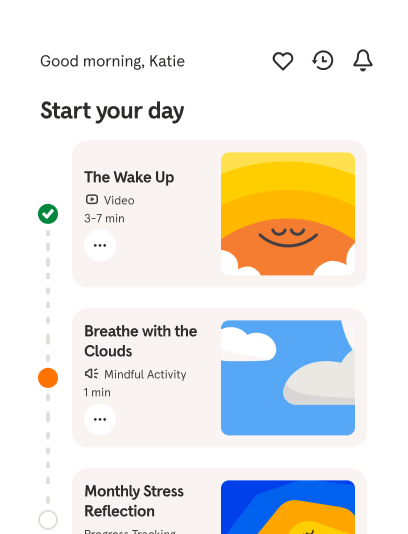Better mental health starts with Headspace. Unrivaled expertise to make life feel a little easier, using guided meditations, mindfulness tips, focus tools, sleep support, and dedicated programs.
Try 14 days free
Welcome to Headspace on anxiety. Now this particular exercise and technique builds very much on the foundation technique that you would have learned. So it's really important that you've learned that in full and that you feel comfortable and confident in applying that technique. Now of course anxiety means something different to everybody. For some people, anxiety in itself may sound a little too strong. It may just be more a sense of an undercurrent, sort of this background chatter, bit of worry that's there and just feels a bit uncomfortable. For other people, anxiety may sound quite tame. It may be that even experienced sort of panic attacks or something, you know, really quite intense feelings of anxiety. But as far as the exercise itself goes, as far as this technique goes, it doesn't really matter where you are on the scale, the same instructions apply. It's really about creating a greater sense of space in the mind. Long term we're talking about changing our relationship with anxiety. Changing our perspective with it. It's not about trying to get rid of anxiety. There's no way that we can get rid of anxiety. Anxiety is part of being human. We have fear in the mind for a very good reasons. Sometimes we need it, it's important. It's only when it starts to become quiet troublesome, when we start to apply it to areas of our life where it's not necessary, where it's not helpful, and where it starts to become quite destructive in some way. That's when it becomes a problem. That as a starting point is really, really important. It's not about getting rid of anxiety, it's about changing our relationship to it, being at ease with it. Fundamentally being okay with anxiety when it arises in the mind so that we don't buy in to it, we don't push away from it, we don't resist it. Instead we're able to just watch it come and watch it go. That is a really comfortable and really healthy place to be in relationship to anxiety. For now you can just take a moment to get yourself into a comfortable position. We're just gonna set the exercise up in the usual way. Then I'm just gonna introduce a second part to the exercise. Just take a moment to settle yourself, eyes open, and when you're ready just taking some nice big deep breaths. As you breath out, just gently closing the eyes, as you just settle in to the different physical senses, and as you settle in to the space around you. As usual, just scanning down through the body, bringing the mind into the body as you just start to become more aware, the physical sensations, and that underlying mood. Just as we did in the foundation exercise, just being clear in your motivation right at the beginning. This isn't about getting rid of anxiety, no matter how strong the temptation may be to think that. This is about changing...
Details
About your teachers
 Andy PuddicomeHeadspace Co-founderMore about Andy
Andy PuddicomeHeadspace Co-founderMore about AndyA former Buddhist monk, Andy has guided people in meditation and mindfulness for 20 years. In his mission to make these practices accessible to all, he co-created the Headspace app in 2010.
 Eve Lewis PrietoHeadspace Director of MeditationMore about Eve
Eve Lewis PrietoHeadspace Director of MeditationMore about EveEve is a mindfulness teacher, overseeing Headspace’s meditation curriculum. She is passionate about sharing meditation to help others feel less stressed and experience more compassion in their lives.
 Dora KamauMeditation TeacherMore about Dora
Dora KamauMeditation TeacherMore about DoraAs a meditation teacher, Dora encourages others to live, breathe, and be with the fullness of their experiences. She loves meditation’s power to create community and bring clarity to people’s minds.
 Kessonga GiscombeMeditation TeacherMore about Kessonga
Kessonga GiscombeMeditation TeacherMore about KessongaKessonga has been an acupuncturists, therapist, and meditation teacher, working to bring mindfulness to the diverse populations of the world.
 Rosie AcostaMeditation TeacherMore about Rosie
Rosie AcostaMeditation TeacherMore about RosieRosie Acosta has studied yoga and mindfulness for more than 20 years and taught for over a decade. Rosie’s mission is to help others overcome adversity and experience radical love.

Your lifelong guide to better mental health
Stress, sleep, and all the challenging emotions — care for your mind with the everyday mental health app that's shown to make a difference.
Try 14 days free
Look after your mind
Proven guided meditations and programs to help you stress less, sleep more soundly, and better navigate life’s challenges

Science-backed
Studies show that using Headspace for 30 days can reduce stress, increase resilience, and improve overall well-being

Explore 1000+ expert-led exercises
Access our library of meditations, breathing exercises, and guidance videos for stress, sleep, focus, everyday anxiety , parenting, and more.




Members are enjoying happier and healthier lives
Related to 'Managing Anxiety'
Frequently asked questions
- Does guided meditation for everyday anxiety work?
Anxiety is a cognitive state connected to an inability to regulate emotions. By using a guided meditation for anxiety, you familiarize yourself with thoughts and storylines that induce everyday anxiety. You learn to see them, identify them, and let them go within an understanding that thoughts do not define anyone. Realizing this means you give thoughts less weight. Within this newfound perspective, you are then able to gradually change your relationship with everyday anxiety, to the extent that it no longer has the same hold over you. One study shows that eight weeks of using the Headspace app results in a 19% decrease in anxiety symptoms.
- How to meditate for everyday anxiety
Sitting still and being with the mind can sometimes feel like the last thing you want to do when feeling anxious. But it’s by pausing, breathing, and meditating that you can actually stop the loop of anxious thoughts. This “force stop” will actually stimulate the parasympathetic nervous system and counter any stress response. When it comes to anxiety meditation, a popular one among Headspace members is this “Managing Anxiety” course, showing you how to breathe through everyday anxiety, release that anxiety, and then manage it, day to day. And as with any guided meditations for anxiety, the key, when anxious thoughts arise, is to return your focus to the breath. This is practice — anchoring your mind to the breath, not the loop of thinking that fuels anxiousness.
- How does meditation help everyday anxiety?
Located deep within the brain’s limbic system are two almond-sized nuclei called the amygdala — these are essentially tiny processing chips that govern our senses, memories, decisions, moods, and reactivity. The amygdala is our emotional thermostat. As with all thermostats, it is susceptible to certain forces, and certainly everyday anxiety. The more anxiety we experience, the more disproportionate the reaction. What’s more, the drip, drip, drip effect of constant anxiousness can reshape the structure and neural pathways of the brain — a process called neuroplasticity. So it follows, then, that a meditation for everyday anxiety would have an opposite, more beneficial effect. In fact, studies using MRI scans show that the amygdala shrinks in response to a meditation practice. As the amygdala reduces in size, the prefrontal cortex — the area of the brain governing our awareness — becomes thicker. And so by meditating, we increase our capacity to manage anxiety. The more we practice guided meditations for everyday anxiety, the more we build this skill for mental resilience.
- What meditation is good for everyday anxiety?
Our “Managing Anxiety” course is designed to help you cultivate a new perspective on the everyday anxiety you experience. It’s essentially an anxiety meditation every day for 30 days, teaching you to have awareness of whatever arises, and then how to move through it, and manage it. The more you learn about everyday anxiety, and the role the mind has in fueling it, the more you can frame it differently; and the more you can do that, the less power everyday anxiety has over you. A body scan exercise is also a good, faster way of dropping out of the head and into the body to calm yourself down.
- © 2025 Headspace Inc.
- Terms & conditions
- Privacy policy
- Consumer Health Data
- Your privacy choices
- CA Privacy Notice


